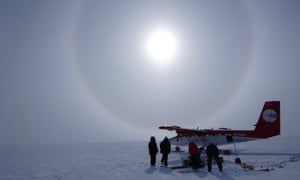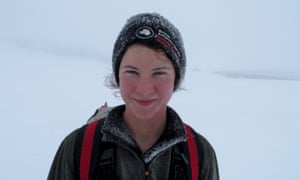Extract from The Guardian
The difficult task of measuring the Greenland ice sheet is vital for
understanding how climate change is changing the polar regions
4 April, 1.35pm
As the Twin Otter plane engines roar into action, the familiar sound triggers a tingle of excitement in my stomach: I’m out on fieldwork.
We are the European Space Agency (ESA) land ice ground team. Our goal is to make measurements of the snow density and layering on the Greenland ice sheet. We will use the data to validate satellite altimetry measurements of the ice sheet surface, to improve the accuracy with which we can monitor how it has changed over time.
As we take off from Ilulissat airport, looking out of the plane I can see a mess of broken icebergs and sea ice in the ocean. Small fishing vessels are dotted around in Disko Bay, leaving a trail of white frothy ocean in their wake.
The boats are dwarfed by the vast size of the giant icebergs that surround them, and serve as a permanent reminder that “normal” life in this part of the world sits at the extreme edge of where humans can live.
We were grounded in Ilulissat for three days before leaving because
of a storm passing through. It’s normal to have bad storms in April, but
none of us expected rain so early in the spring. A local dog sled owner
I spoke to said that he had never seen it rain in Greenland at this
time of year.As the Twin Otter plane engines roar into action, the familiar sound triggers a tingle of excitement in my stomach: I’m out on fieldwork.
We are the European Space Agency (ESA) land ice ground team. Our goal is to make measurements of the snow density and layering on the Greenland ice sheet. We will use the data to validate satellite altimetry measurements of the ice sheet surface, to improve the accuracy with which we can monitor how it has changed over time.
As we take off from Ilulissat airport, looking out of the plane I can see a mess of broken icebergs and sea ice in the ocean. Small fishing vessels are dotted around in Disko Bay, leaving a trail of white frothy ocean in their wake.
The boats are dwarfed by the vast size of the giant icebergs that surround them, and serve as a permanent reminder that “normal” life in this part of the world sits at the extreme edge of where humans can live.
Rain is just temporary weather and shouldn’t be mistaken for longer-term more permanent climate change. However, records from the Danish Meteorological Institute (DMI) show that the frequency of abnormally warm temperatures in Ilulissat is increasing, so rain storms such as the one we experienced are further evidence that the polar regions are changing rapidly.
Time on the ice is limited today. We waited on standby all morning hoping for the wind speed to lower enough for us to take off, and for satellite images to show the cloud clearing up on the ice sheet. Weather delays can pull the plug on the best laid plans at any moment.
Now in the air, crammed in between the radar and ice coring kit (essential for our scientific experiments), a heap of down jackets, boxes of Icelandic chocolate bars and the spare fuel tank, we plan our time carefully.
Our field site is located next to Jakobshavn Isbrae, the fastest glacier in the world, which satellites have shown is thinning at a rate of over 20 meters per year at its terminus. That’s ice the height of a five-storey building, lost every year.
4 April, 4.30pm
As the plane touches down, we bounce over hard sasstruggi, and special skis fixed around the wheels prevent us from sinking into the snow. These snow “dunes” are formed by persistent winds blowing the snow into sculpted ridges.
The moment we land, a blast of cold dry air hits us and our breath is immediately visible, growing in clouds around us. It’s -36C outside, but there is barely any wind so it’s a beautiful day for ice coring.
Ines, our PhD researcher, starts the magnaprobe experiment, using an instrument that measures the depth of the very top snow layer. She looks like a hi-tech ghostbuster, walking around the site with the backpack on and a large probe.
For Ines, this campaign is particularly exciting as it’s her first time on an ice sheet, but this will be my fifth trip. As with every research project I work on, our team is an international group of scientists from France, the UK, Denmark, Brazil, Portugal, Italy and the US.
We only have an hour on the ground, so Sebastian Bjerregaard Simonsen,a colleague from the Danish Technical University,and I work together as a slick team, systematically drilling down through the ice sheet roughly 80 centimetres at a time, then hauling the heavy drill out of the ground. As we huddle round the barrel to push the section of core out, we are both excited to see the layers of snow and ice revealed for the first time.
The ice core looks like layers of a cake, with thicker opaque white sections of snow interspersed with thinner layers of water ice. The thickness of the layers isn’t even, and it tells us a story about warm melt events that have taken place over the last 10 years on the Greenland ice sheet.

Just as we hit our target depth of seven metres for the ice core, the airborne team overfly us, collecting radar measurements of the snow layering. With all the experiments successfully completed, we fly back to Akureyri.
4 April, 7.30pm
As dusk turns to night we touch down at Constable Point on the east coast of Greenland for the final refuelling stop before heading back to Iceland. We will be analysing the ice cores through the night. Once the cores are pulled up from the ground it’s a race against time to collect the measurements we need before these long tubes of ice start to melt. There are no freezers big enough to preserve the intact cores so we have to burn the midnight oil.
5 April, 5am
By sunrise the next morning we are all wide-eyed and exhausted, but it’s a small price we are happy to pay. The future most likely holds extreme change for our planet’s environment, and the polar regions are already evolving rapidly. The data we have gathered on this campaign will be used to improve how satellites measure changes in the ice sheets. This data is critical as it is currently the only method we have of monitoring sea levels in Greenland, and are used for flood defence planning along coastlines around the world. It’s a privilege to be in the field contributing to that understanding first hand.
- Anna Hogg is a research fellow in the Centre for Polar Observation and Modelling at the University of Leeds

No comments:
Post a Comment